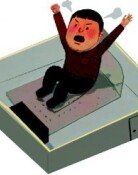Korean Hospitals Competing to Get Bigger
Korean Hospitals Competing to Get Bigger
Posted April. 18, 2009 09:33,
Korea`s era of super-size hospitals with more than 2,000 beds was ushered in yesterday, as Asan Medical Center, Yonsei University Severance Hospital and Samsung Medical Center admitted more than 2,000 patients.
With Seoul St. Mary`s Hospital, which reopened March 23, also jumping on the mega-size hospital bandwagon, major hospitals in the country are scrambling to attract more patients to increase the number of beds to 2,500. Hospitals call this competition an arms race. The first race was to expand from 1,000 to 2,000 beds, and the second has a mark of 2,500.
The competition for hospital expansion among a small number of large hospitals will enhance specialization in medical care. Medical experts warn, however, that heated competition will threaten the publics right to health by destroying medical delivery systems and increasing medical expenses.
▽ Unlimited hospital enlargement
The top five hospitals except for Seoul National University Hospital each have 2,000 beds.
At Seoul St. Mary`s Hospital, a new building that opened last month with 1,200 beds raised the number of the hospital`s beds to 2,050. By surpassing the 2,000 mark in 1995, Asan Medical Center is a leader in this competition and now provides inpatient care for 2,670 patients. Severance Hospital holds 2,050, Samsung Medical Center 1,933 and Seoul National University Hospital 1,600.
The steep increase in hospital beds is attributed to the revision of medical law in 2000 that lifted the cap on the number of beds.
▽ Special centers
Rather than increasing the number of ordinary sickbeds, the five largest hospitals are focusing on enlarging special care units to gain a comparative advantage. Asan Medical Center has remodeled part of the hospital to open a cancer ward with 770 beds. The hospital runs 10 special care units specializing in cancer, organ transplant, heart disease and diabetes.
Seoul National University Hospital operates cancer and breast centers and plans to remodel its existing cancer center by August next year. Seoul St. Mary`s Hospital runs key care units for cancer, organ transplant, cardiovascular disease and opthamology and 10 centers including those for spinal health and brain tumors.
Severance Hospital will build an 11-story integrated cancer center by 2013 and Samsung Medical Center, which has nine special units, will open an expanded cardiovascular center in July.
The ultimate goal of these hospitals is to be reborn as super-sized hospitals equipped with high expertise. To this end, they are also expanding outpatient care.
A source at Seoul St. Mary`s Hospital said, On Tuesday, four weeks into the opening of the hospital, we treated 5,000 outpatients. Since the opening, the daily average number of outpatients has grown 35 percent from 3,700 last year, the hospital said.
▽ Widening gap among hospitals
As the big five hospitals are enhancing their expertise and enlarging outpatient care, the gap between them and other hospitals in the Seoul metropolitan area are intensifying. The disparity between large hospitals in the capital area and those in provinces has also steadily grown. Though big-budget latecomers are jumping into the competition, the gap will not be narrowed soon, experts said.
Under law, non-profit corporations can set aside up to 50 percent of annual sales for business reserve funds to extend and renovate hospital buildings and purchase new medical equipment. This means the business reserve funds of other hospitals cannot hope to match those of the five largest.
Kim Ki-ho of the National Competitiveness Committee said, Large hospitals run by private universities such as Severance Hospital can accumulate at least 10 billion won (7.5 million U.S. dollars) in business reserve funds.
He added certain hospitals with large reserve funds have gained the upper hand in the second arms race.
▽ Fears over publics right to health
Critics say the widening gap among hospitals will undermine the medical delivery system and increase the financial burden of patients, threatening the publics right to health.
Lee Jin-seok, a medical management professor at Seoul National University, said, The unit production cost of large hospitals is twice that of other ordinary hospitals.
To make up for this, they increase medical services not covered by insurance such as ultrasonography, resulting in a heavy burden for the public.
This view is supported by medical insurance statistics. According to the 2006 daily medical fee data for the same disease with the same severity, general and specialized hospitals charged 90 percent more than ordinary hospitals for simple surgery such as an appendicitis operation.
General and specialized hospitals charged 80 percent more for asthma and 60 percent more for laparoscopy for cholelithiasis.
If the government introduces market-oriented healthcare policies, the nations healthcare system will fundamentally be threatened, Lee said.
The government should devise measures that enhance the coverage of health insurance by adopting the diagnosis group method and a family doctor system for the population.
nuk@donga.com baron@donga.com







